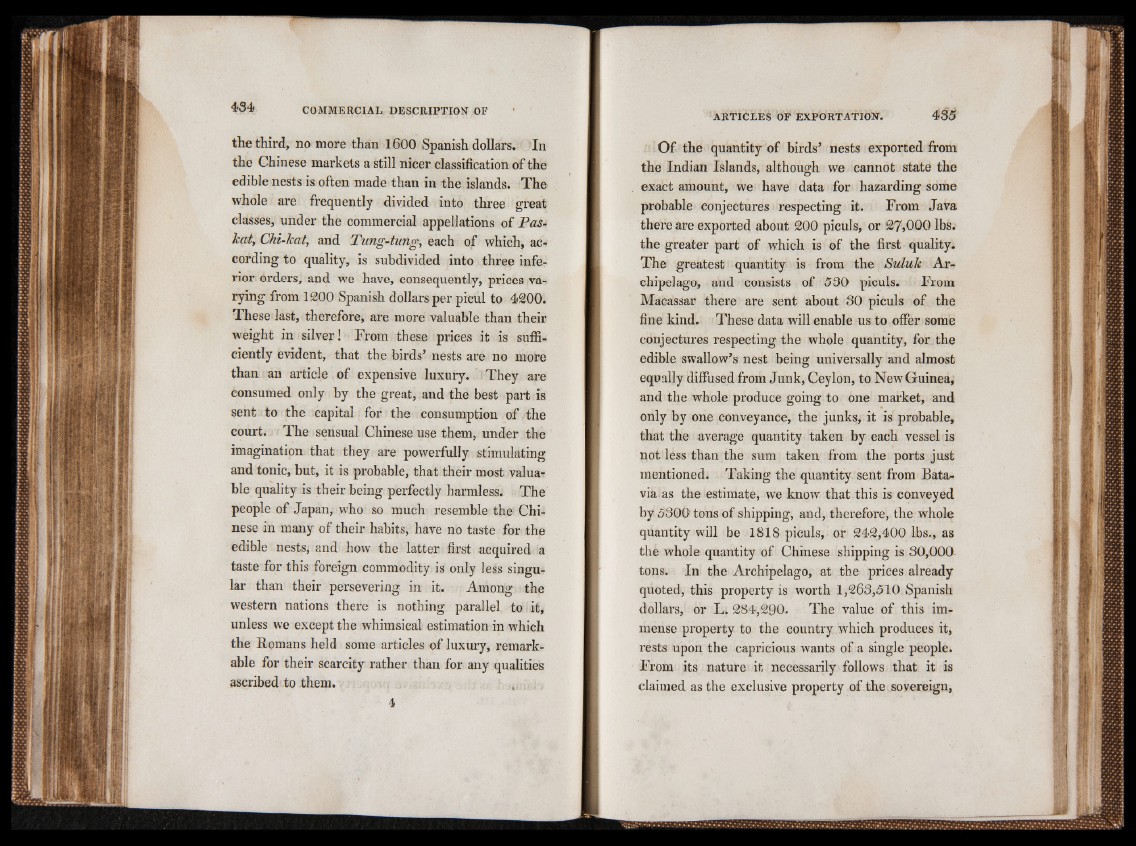
the third, no more than 1600 Spanish dollars. In
the Chinese markets a still nicer classification of the
edible nests is often made than in the islands. The
whole are frequently divided into three great
classes, under the commercial appellations of Pas-
Teat, Chi-Jcat, and Tung-tung, each of which, according
to quality, is subdivided into three inferior
orders, and we have, consequently, prices varying
from 1200 Spanish dollars per picul to 4200.
These last, therefore, are more valuable than their
weight in silver! From these prices it is sufficiently
evident, that the birds’ nests are no more
than an article of expensive luxury. -They are
consumed only by the great, and the best part is
sent to the capital for the consumption of the
court. The sensual Chinese use them, under the
imagination that they are powerfully stimulating
and tonic, but, it is probable, that their most valuable
quality is their being perfectly harmless. The
people of Japan, who so much resemble the Chinese
in many of their habits, have no taste for the
edible nests, and how the latter first acquired a
taste for this foreign commodity is only less singular
than their persevering in it. Among the
western nations there is nothing parallel to it,
unless we except the whimsical estimation in which
the Romans held some articles of luxury, remarkable
for their scarcity rather than for any qualities
ascribed to them.
Of the quantity of birds’ nests exported from
the Indian Islands, although we cannot state the
exact amount, we have data for hazarding some
probable conjectures respecting it. From Java
there are exported about 200 piculs, or 27,000 lbs.
the greater part of which is of the first quality.
The greatest quantity is from the Suluk Archipelago,
and consists of 530 piculs. From
Macassar there are sent about 30 piculs of the
fine kind. These data will enable us to offer some
conjectures respecting the whole quantity, for the
edible swallow’s nest being universally and almost
equally diffused from Junk, Ceylon, to New Guinea,
and the whole produce going to one market, and
only by one conveyance, the junks, it is probable,
that the average quantity taken by each vessel is
not less than the sum taken from the ports just
mentioned. Taking the quantity sent from Batavia
as the estimate, we know that this is conveyed
by 5300 tons of shipping, and, therefore, the whole
quantity will be 1818 piculs, or 242,400 lbs., as
the whole quantity of Chinese shipping is 30,000-
tons. In the Archipelago, at the prices already
quoted, this property is worth 1,263,510 Spanish
dollars, or L. 284,290. The value of this immense
property to the country .which produces it,
rests upon the capricious wants of a single people.
From its nature it necessarily follows that it is
claimed as the exclusive property of the sovereign,